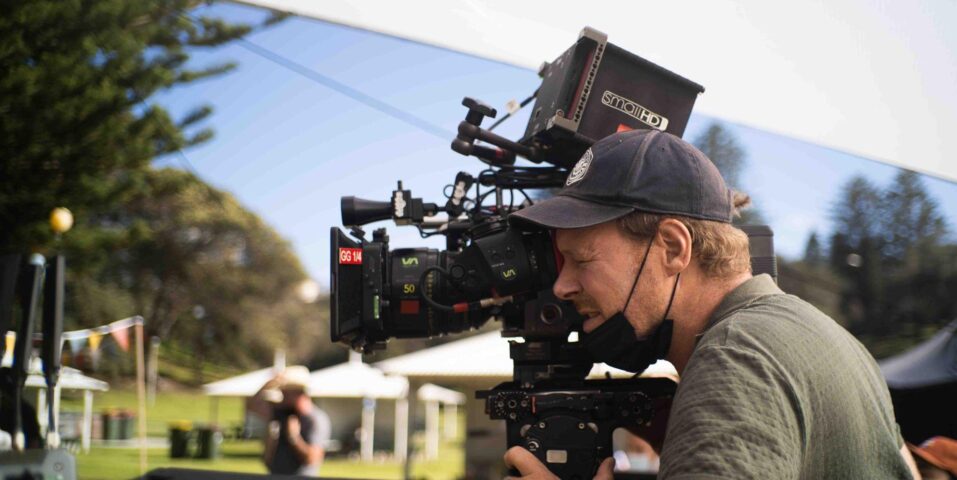Award-winning Australian cinematographer Dan Freene is best known for his flexibility in visual storytelling, understanding of light, and ability to make his leading actors look their best. Over his dynamic career, Dan has earned a reputation for being a master cinematographer who can deliver exceptional results in various challenging situations.
Specialising in feature film, television, documentaries and commercials, Dan has recently completed principal photography on the series Queen of Oz, featuring British comedian-actor Catherine Tate. In the first half 2022, Dan shot the highly anticipated Netflix comedy series starring Celeste Barber, Wellmania. Dan’s dynamic career includes other notable projects such as the Netflix sci-fi feature film Other Life and, in 2010, the critically acclaimed feature film Wasted on the Young.
Here are some of highlights from a recent Q&A screening of Wellmania at AFTRS partnering with ACS and Sony, hosted by Nick Rowe. In this conversation, we delve into Dan’s experience in various mediums, from early visual experiments in photography to his transition into cinematography and technical insights on the Netflix production.
Early visual experiments – from photography to cinematography
Dan’s love of cinematography started with his mother watching films and reading film reviews. He later began to photograph, and his technical skills using the camera led him to experiment with shooting a short film that empowered his vision to work in the industry. His love for cinema and photography informed his cinematographic approach.
Dan: “Probably my love of film started with my mum because she was a real film buff, and we used to stay up late on Friday nights watching Bill Collin’s Golden Years of Hollywood. We would religiously watch it every Friday night, and there were often doubleheaders. We would watch, and then we’d talk about the films. “
“But then I went and did a whole bunch of things before I became a cinematographer. Photography being one of those things for about five years. And then I got introduced to cinematography through a friend of mine [Myles Conti] who’s here tonight, who talked me into shooting a short film. And I just fell in love with the moving picture and realised that that was where I was going to go. That was in 2001.”
The challenge presented by Myles was the Newcastle 24 Hour Film Festival, where filmmakers come together in one place to make a short film in 24 hours. The team devised an insightful way of building the short film on camera by recording a ten-minute scene, rewinding the tape, and populating it with intercut scenes recorded over the original. Onto [short film] ended up being a fascinating filmmaking experiment that led Dan and Myles to be interviewed by the panel of judges to explain the brilliant process, as the panel questioned how such a result could be achieved without utilising editing software.
Dan:
“The whole concept is you’ve got 24 hours to make a film, and you’ve got to edit the film in camera, which is amazing.
It’s one of the greatest learning tools you can ever give yourself as a director or a filmmaker because you’ve got to edit everything on camera.”
Dan: ”And we had a blast making this thing. It was just so much fun. And, you know, coming from stills and moving into cinematography, the learning curve was very steep because even though you’ve got framing and lighting from stills photography moving into the moving picture, there was a lot to learn, editing, staging and coverage and these things that you don’t do in stills photography.”
Once the passion for cinematography was ignited, Dan started collaborating with AFTRS students on their short films and attending AFTRS short courses that enabled him to learn from industry professionals. He discusses his involvement with AFTRS during this pivotal period of his career.
Dan: “In the early noughties, I used to come to AFTRS, and I used to assist on a lot of the school film projects. I probably assisted on six or seven film projects. And then I used to come to all of their short courses.”
Career Developments – From Tropfest to Wellmania
From his career inception, Dan kept developing personal projects, eventually gaining notice with projects like Marry Me, which won a Tropfest award in 2008, and Wasted on the Young, a critically acclaimed successful feature film about a high school party that goes dangerously off the rails and a teenager that finds revenge just a computer click away.
In 2022, Dan joined the Netflix comedy series Wellmania as a cinematographer. The series stars Celeste Barber, who’s character has a major health crisis and is forced to rethink her “live fast die young” attitude.
He shares how the early projects enabled him to achieve technical and creative growth through practice.
Dan: “That was fun. In 2008, I shot [Marry Me], it was actually a family– made film. My wife was the production designer, best friend directed it, her husband edited it and her brother-in-law produced it. So it was a really small crew. We really made the thing with about five or six people and won Tropfest that year. It is a really gorgeous little movie, like a really cute little tale. At the time Tropfest was a really big deal, it was the biggest short film festival in the world.”
Shortly after being awarded by Tropfest, Dan shot his first feature, Wasted on the Young, directed by Ben C. Lucas.
Dan: “That was a really great production in WA that was funded through Screen West, and it was one of those blessed productions where we had lots of ambition and just enough money to get it done. But we had to be very clever about how we did things to get the result. And yeah, it was a screaming success, you know, premiered at Sydney Film Festival and sold really well around the world and it’s still a really good movie. I still think it’s probably the best thing I’ve ever done in terms of finished work.”
Since shooting Wasted on the Young in 2010, Dan has consistently worked as a Director of Photography, leading him to a phone call from Netflix when he least expected it.
Dan:
“Like all great film stories, they start with a phone call at a random location. I was with my wife in Hawaii, and I think it was the 30th of December, and we’d been hiking some volcano or something. I got back, and the phone was in reception, and it was my agent. And she’s like: “There’s a Netflix series called Wellmania starring Celeste Barber. Are you free to do it? The answer is yes.” And I was like, “Yes!”.“
Technical and creative insight – moving locations and moving actors
Wellmania was a fast production with challenging scenes and locations. Dan shares the importance of staying focused during the pre-production and production period, constantly re-evaluating and preparing for the next day so that everyone can do their work smoothly and perfectly.
Dan: “Most of those locations were not found until we were shooting. And in fact, a lot of those scripts were still being finalised. So you know, you’re kind of there and once you are shooting the first four episodes in the first four weeks, and every night you’re getting new scripts.”
“You can’t just turn up on the day and go, “oh, what am I doing?” The strategies that I leant on was out of location department. They were really pushed, so I put a lot of pressure on the producers to get some more location manager and location scouts. We got a couple more location scouts working straight away. And the trick is not wasting time looking at dead locations. Every lunch break we would have a location meeting, for just 10 minutes, just to make sure that they’re not wasting time. And they’re like “I’ve got these six locations” and you’re like, “No, no, no. Look at that one. Go to that. Take photos.” And then you know, that afternoon after you finish shooting, check the shots and it looks pretty good, so you ask, “Can you go back there and can you take photos from this spot in this direction on this lens, shoot the reverse, and so on.”
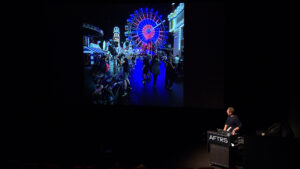
Dan Freene explains details about shooting Wellmania in location.
Shooting the eight episodes of Wellmania gave Dan greater control over the look of the series and the functioning of the crew on set. His diligent pre-production was essential in maintaining a balanced set and running production, even facilitating an easy handover because of COVID conditions.
Dan: “I shot it all. But I think that if you’re the setup DP [Director of Photography] of any show, you should be able to share your vision and notes. Someone else should be able to take over as long as I can do the job properly, and you make sure you cast properly for it.”
“I did have another DP help me out because towards the back end of the series. We were making this right in the heat of COVID and everyone got sick at some stage.”
“So Frank [Flick] took over for me for three days and the transition was pretty flawless because I am quite fastidious with my pre-production notes. I just handed Frank everything I had and I’m like: “This is what we’re doing, this is what it looks like. And he’s like: All right! So you know, like it’s nice to go.”
Dan emphasized the technical aspects of shooting Wellmania, explaining the importance of shooting in full frame for comedy, especially for two-shot compositions, and the need for a 4K deliverable.
The decision to shoot the series with the Sony Venice was considerate of the actors’ comedic language, allowing the comedic gags to happen simultaneously in the frame, and because most of the shoot would happen on practical locations that require more control over the depth of field. The camera’s ability to handle low light conditions and its X-OCN codec were also critical factors in his choice.
Dan: “I’ve shot a lot of comedies before and comedies are really told in the two shot.”
“I also knew that I’m going to be shooting in practical locations. So I knew that space was going to be limited. And so I didn’t want to shoot on a standard Super 35 sensor because it meant that I wouldn’t have as much control over the depth of field as I would have with a larger format sensor.”
“The next part of the decision was kind of dictated a little bit by the fact that Netflix were involved. So firstly, they dictate, of course, a 4K deliverable. And look, there’s other manufacturers out there that are 4K cameras, but you know, I didn’t want 3.2 K, I wanted proper 4K and so I wanted full frame 4k.”
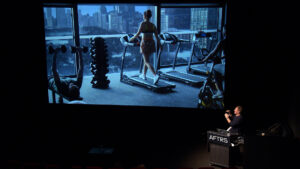
Dan Freene presenting examples from Wellmania.
“We were doing what’s called an HDR grade, which is a high dynamic range grade. But you need to have a camera sensor that can get all of that information. And so I was adamant that I needed to shoot a raw codec. I didn’t want to shoot Prores because Prores can often have noise in the shadows.”
Shooting in low light conditions was an essential consideration for Dan when selecting the production camera.
Dan: “So a lot of camera manufacturers fudged the numbers but this one’s really true to the point, if you went outside now and you turn that camera on at 2500 ISO, you’re literally seeing more than your eye can see. So when you’re shooting at night, it can make you very efficient and fast, you end up cutting lights in the city because the stray light hits your actors and so on.”
“The Sony Venice has got this fantastic codec which is called X-OCN. And it’s a wide colour gamut and high dynamic range raw codec, and there’s three different settings of it. And the other thing that I know with that codec is that post [production] in Australia, love it, which is also a big thing because post always have a really strong arm in terms of how you shoot and what you shoot and how much data you shoot and so on.”
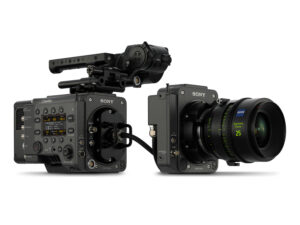
Sony Venice Extension System.
Dan explained how using the Venice Extension System [Rialto] was essential to shoot in tight locations, including an ambulance scene. The extension System enables a cabled separation of the Venice camera body and image sensor block by up to 5.5m, with no degradation in image quality, making it exceptional small, more mobile and light.
Dan: “The Rialto is just like a sensor, and you tether it to a Venice body. But that means you’ve got this tiny little camera that you can put into spaces where you can’t put a normal camera, like into cars and into bathrooms and into city bars, you know, practical locations that are really tight.”
“I knew I was going to use it in some of those tight bathrooms and toilets, but because we had it, I used it pretty much every night in some way, shape or form. Even just in a regular set. Like you’d be surprised, when you’re shooting in practical, real locations, how often you get compromised by the size of your camera body.”
One of the situations when this gadget was useful was when shooting the opening scene of the ambulance.
Dan: “The series opens up in the ambulance, this was shot with the Rialto, I’m actually in the ambulance and quite close to the performers. And the only way we’re going to get that was shot it on handheld. And when you’ve got a very small camera, you can get it into a tight environment. And these ambulances are not big.”
The opening scene was fundamental to engage the audience from the start. Working with Netflix meant that extra attention was dedicated to the first minutes of the episodes and the series’ first episode.
Dan: “The [Netflix] algorithm goes something along the lines of: if you retain someone’s attention through the first 5 minutes, the retention rate of getting that person to stay subscribed or stay on that series is something like 80%.”
“If you get in through the first 5 minutes, the next drop off is at 12 minutes and then if you keep them, I think it’s a 67% chance of keeping them through the first two episodes.”
“And if you keep them for the first two episodes, they’ll watch the series and that’s the algorithm.”
Dan spoke about the creative decisions made to capture a bright and colourful Sydney for Wellmania, in contrast to darker Australian dramas, noticing aesthetic differences between shooting in Australia and in the United States. He also shared insights into working with comedian Celeste Barber, emphasiszing the importance of giving comedic actors room to improvise.
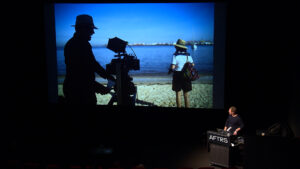
Dan Freene talks about shooting Wellmania in Sydney locations.
Dan: “They knew what they didn’t want. The Americans are like: “You know, you Australians, you always shoot everything so dark and desaturated.” You know, referring to Australian drama. “We don’t want that. We don’t want dark, we don’t want desaturated, we want bright, we want colourful.”
“What they wanted was Emily in Paris, a Sydney version of Emily in Paris. They wanted to postcard the city. Beautiful blue skies, blue ocean, poppy colours, every kind of Sydney landmark you can get in the show, which is tricky because those landmarks are hard to shoot.”
Dan: “They’re always in locations that are not very film friendly. It sounds lovely shooting scenes with the Harbor Bridge and the Opera House in every shot. But in reality, you’ve got to get an entire film crew there and you’ve got a set, it’s not it’s not an easy thing to do.”
To achieve the proposed look, Dan stressed the significance of a well-designed LUT [Look-Up-Table] to maintain a consistent look throughout production and post-production.
Dan: “It’s called a look-up-table [LUT] and you can load it into your camera and it’s basically colour science that will make the image look a certain way. From each day that you’re filming the footage and you’re sending to the producers overseas, it has got a bit of a colour grade on it. Which is so important because what happens is your producers and crew are watching the rushes, from the first week of shooting, everyone’s looking over your shoulder, all the major players. If they love it, it’s amazing. It’s like we’re in the good books and you only get that by creating a LUT. We created a LUT for New York and then a LUT for Australia.”
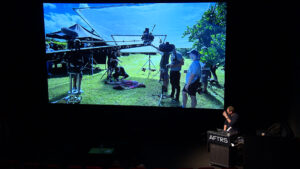
Dan Freene talks about shooting Wellmania in Sydney locations.
The LUT preparation included a detailed approach centred on the locations and the main character.
Dan: “What I did in pre-production, I got a look-a-like for Celeste Barber, same skin tone and all the rest of it. I had our costume designer, Gypsy Taylor to give me everything she could. And then we went out and we shot all this footage. We shot in the city at night, and then we shot some stuff in a studio, we got some brick walls, we did some New York looking stuff as well. And then together with [colourist] Adrian Hauser, we created these LUTs and I wanted them to be really accurate.”
The LUT proved immensely important for pre-production and post-production as a colour grading guide.
Dan: “We were in discussions with all the producers for many weeks about how the show is going to look. So everyone kind of knew where we were heading. But then that LUT, six months later, when we were grading, these LUTs became amazingly important.”
“Then talking to other DP’s around the world and on much bigger shows with DITs [Digital Imaging Technician], the LUT is like gospel, to the point where a lot of those larger shows, a lot of the DP’s don’t even sit in on the grade because that is handled that well. You have multiple cameras and you’ve got a team of daily colourists that are working on the LUT. So, when it comes to doing the final grade, the work has kind of already been done.”
“I’d go in with really particular LUTs on anything I do in the future because people fall in love with that look. As cinematographers, you want to protect the image, you want to give it to them as close as possible as to what it’s going to look like at the final result.”
Dan talks about working with Celeste Barber and how she impressed everyone with her exceptional work ethic on set. Celeste had to learn at least two pages of dialogue every day due to the changing scripts and despite her workload, she often requested additional lines for her character to make the scenes more enjoyable.
Dan: “Celeste, she was a Trojan. She was so amazing. I mean, she’s in every scene. And so every day she would have had minimum two pages, which is a lot to learn every single day. So every night when we go home, she goes home and learns the next day’s pages because the scripts are changing, and you can’t learn a whole series worth of dialogue. She had such a great work ethic. But then she would put down [film] a couple that were scripted and then she’d be like, “I just want one for me”. And then she would do something special. In retrospect, I wish we could have given her more time to do the improvised takes.”
For Dan, flexibility is critical in comedic acting because comedic performers need the freedom to improvise and move around, influencing how scenes are shot. Unlike drama, where the film often takes precedence over the performance, in comedy, the focus is on humour and space for expression, which leads to a more dynamic and loose shooting style.
Dan:
“You know what tends to be funny is generally when you give actors the room to be able to flex a little bit. It affects the way you shoot as well, because the last thing you want to be doing as a cinematographer with comedic actors is cornering them into a space and going, “Well, you know, you’re light is here, you’ve got to be there, you’ve got to stand here and you can’t move around.”
Dan: “Comedy is the opposite. You’ve got to give them the floor. So it changes the way you work. You’ve got to shoot a lot wider. You’ve got to shoot looser and try to give them more time on the screen. Generally with drama, everything’s kind of controlled and pretty. You got to land on a spot and it’s going to be lit and that’s where you will do your line. And we as filmmakers, we often put the film in front of the performance with drama, but with comedy, it’s got to go the other way round. It’s all about the funnies first. And you’ve got to give the performers room to move.”
Dan’s Q&A concluded with questions from the audience, including technical details about transitions, lighting techniques, and shooting party scenes in Wellmania.
Audience: “Were the [editing] transitions done in camera or post?”
Dan: “We did have one day of shooting pick ups, in Bondi. And so we went down there and shot all those swiping things. You get notes from the editor and go: “Give me one from left, give me one left, one right, one up, one down.” And so you go and shoot all this stuff. You know, it’s like you build it into the coverage.”
Audience: “How did you light the big party scene?”
Dan: “So, when you got really bright windows outside, the only way you’re going to lift the inside is by adding light in. So we had a couple of four, maybe two fours and a six actually I think it was all coming through the window light and we shot one direction first and then turn around and shoot the other direction. So tThat location is at Luna Park. The idea was that we needed to set ourselves at Sydney Harbour, so it was either Harbour or Opera House. So it’s like, you know, five stops brighter out there than it is here, so the trick is to balance it.”
The conversation was followed by a special screening of Wellmania.
The panel was organised by Simeon Bryan, AFTRS Senior Lecturer in Image and Vice President of ACS [Australian Cinematographers Society] in partnership with Sony Australia, providing valuable insights into the technical aspects of cinematography and the importance of practice in developing creative skills.
Thank you, Dan, for being so generous with your time and sharing your creative and technical insights with the upcoming generation of cinematographers and filmmakers.

